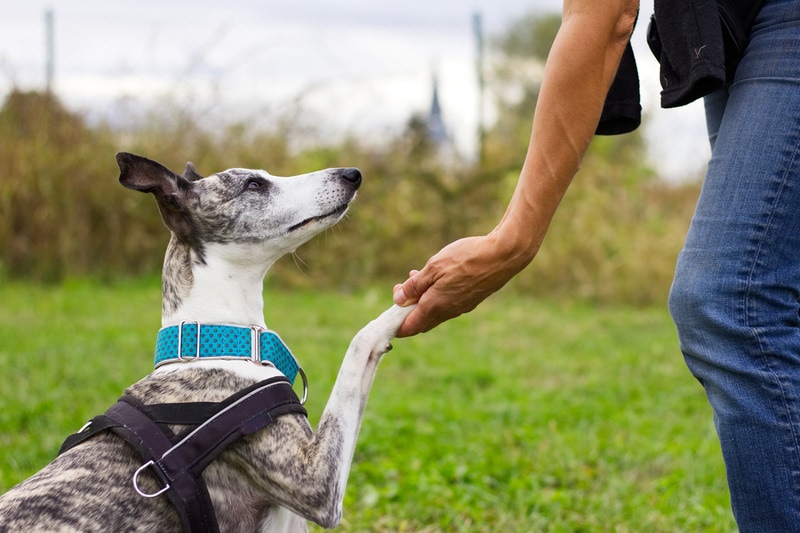Boston Terrier Pregnancy: Vet-Approved Gestation Facts & FAQs
Updated on
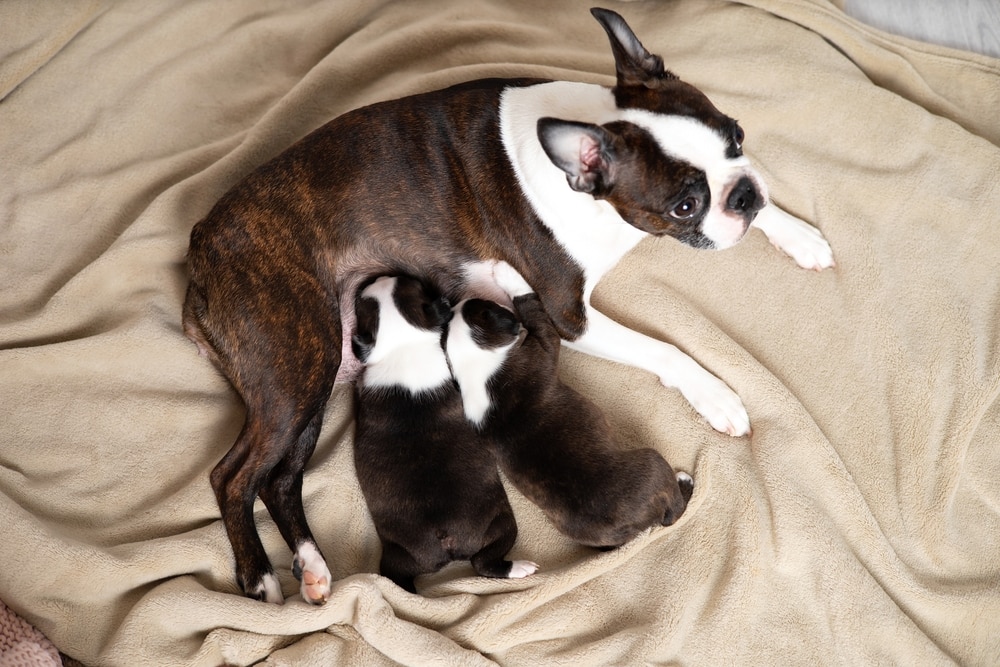
The world of dog breeding is a stressful but beautiful one. Most experienced dog breeders will tell you that witnessing the successful birth of a litter of puppies is so rewarding, but the journey along the way requires plenty of research, breed knowledge, time, and money. Breeding Boston Terriers is particularly tricky because they often have birth complications.
To ensure the safety of your dog, as well as their litter of puppies, you’ve got to be prepared for what to expect. We’re going to look at the ins and outs of Boston Terrier pregnancies, from when to start breeding them to setting up their birthing area. Let’s get started!
At What Age Can I Breed My Boston Terrier?
Boston Terriers experience their first heat cycle between 6–8 months of age. Going into heat is a normal part of a female dog’s life, and for Boston Terriers, it can last for as long as 21 days and will usually occur twice a year or every 6 months. The heat cycle is an indication that your dog has reached sexual maturity and is able to mate and reproduce.
However, their heat cycle isn’t an indication that their bodies are fully grown or that they’re emotionally mature enough to give birth to and care for their puppies. To allow time for your Boston Terrier to become mentally ready for breeding, you should wait until they’re 2 years old. In fact, the AKC won’t register Boston Terrier puppies if the mother fell pregnant with them before reaching 8 months old1.
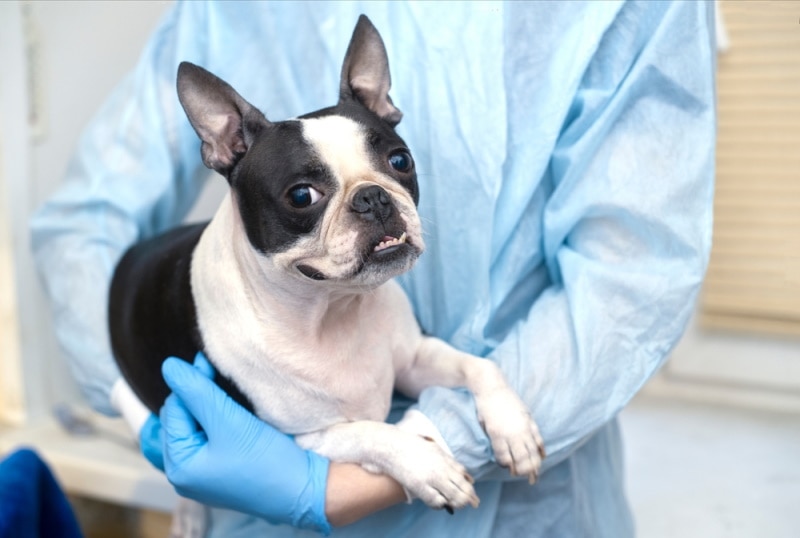
The Heat Cycle
Your Boston Terrier goes through different stages when they’re in heat. These stages are important to know because they’re not fertile the entire time, and for a period of time, they won’t allow males to mate with them.
- Proestrus – Your Boston Terrier will remain in stage 1 for around 9 days. During this time, she’ll bleed. Males will try to make advances on her, but she’ll show disinterest and reject them.
- Estrus – Stage 2 can last from 3 to 11 days. During this time, your dog will be most fertile and will allow male dogs to make advances on her, which usually results in mating. A sign that this stage has begun is the decrease in your dog’s bleeding. If you want to breed your Boston Terrier, this is the stage you’ll need to do it in.
- Diestrus – During this stage, your female Boston Terrier’s body will go back to normal, with the bleeding coming to a complete stop. Your dog will also no longer engage in mating.
- Anestrus – This is the stage between your dog’s heat cycles, which can last between 5 and 6 months.
How Long Are Boston Terriers Pregnant?
If your Boston Terrier successfully mated and was fertilized during the Estrus stage of her cycle, she’ll soon start showing signs of pregnancy and give birth to a litter of puppies not too long after. A Boston Terrier is usually pregnant for around 63 days, counting from the day conception occurred. Conception may not have occurred on the same day that your dog bred with the male, as it can sometimes occur a few days later.
When you take your Boston Terrier to the vet to confirm the pregnancy, they’ll want to know when they were bred, so write the date down or put it in your calendar to prevent you from forgetting those details.
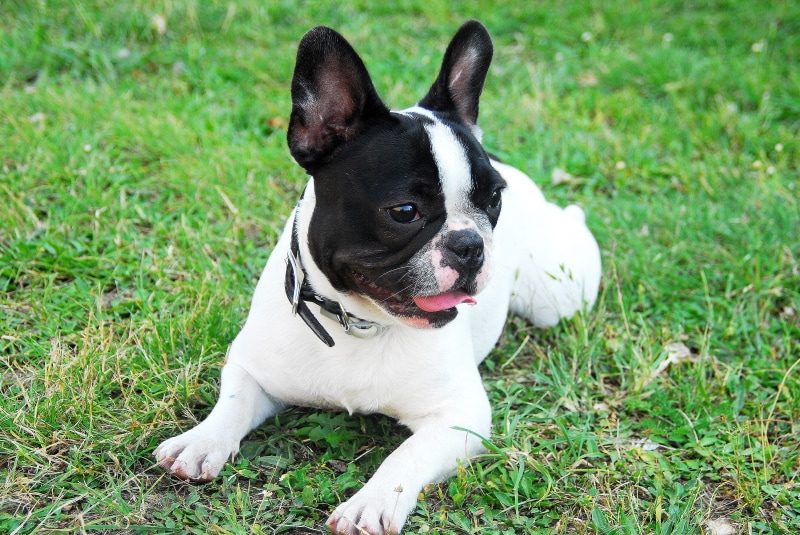
The 4 Methods Vets Use to Diagnose Pregnancy in Boston Terriers
Unfortunately, you can’t determine whether your dog is pregnant or not by having them urinate on a pregnancy test. However, veterinarians can detect the heartbeats of your dog’s puppies by the end of the first month of their pregnancy. To take any guesswork out of the equation, veterinarians use a few methods to diagnose pregnancy in dogs.
1. Palpation
If your dog is between 3 and 4 weeks pregnant, the veterinarian can perform abdominal palpation. This method involves the veterinarian touching and feeling your dog’s abdomen for fluid-filled sacs that surround the growing puppies. However, this isn’t the most accurate method, and after 4 weeks, the veterinarian will no longer be able to perform it.
2. Hormone Tests
Once your dog has reached day 30 of her pregnancy, the veterinarian can test her blood for specific hormones that are only produced during pregnancy. If the hormone results come back positive, your vet will be able to confirm the pregnancy.
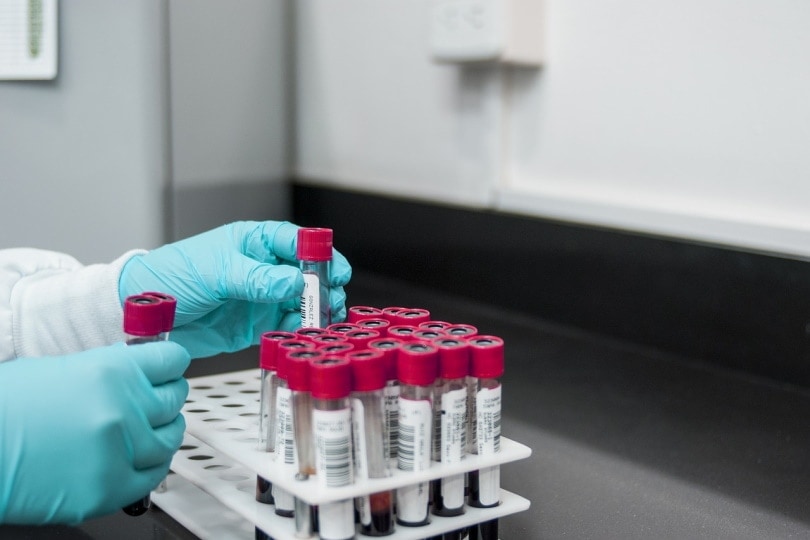
3. Ultrasound
This method is the one you’re probably most familiar with because it’s used in human pregnancies too. It’s a great way to determine whether your dog is pregnant early on, as it can be performed from around 25 days into the pregnancy. The ultrasound can confirm the pregnancy, give the vet an indication of how many puppies your dog is pregnant with, determine the gestational age of the puppies, and pick up on the fetal heartbeats.
4. X-ray
Although an x-ray will be able to detect how many puppies your dog is carrying, to help you better prepare for the birth and care of the litter, it can only be done from around day 55 of the pregnancy. Before this stage, the puppies’ skeletal systems won’t be visible on the x-rays.

 Boston Terrier Pregnancy Symptoms
Boston Terrier Pregnancy Symptoms
Your vet may have already confirmed your Boston Terrier’s pregnancy, but it’s always nice to know what signs to look out for when walking this special journey alongside your dog. Experienced breeders may know what signs to look out for to determine whether their dog is pregnant, but if breeding happens without their knowledge, they may easily miss them.
- Nausea
- Vomiting
- Change in appetite
- Increase in affection
- Less activity
- Growing nipples
- Irritability
- Weight gain
- Nesting
- Increased urination
- Firm abdomen
- Movement in their abdomen
- Restless behavior
- Excessive panting
- Digging
 Top 3 Tips to Start Getting Ready for Birth
Top 3 Tips to Start Getting Ready for Birth
Once your dog enters their third month of pregnancy, you may want to start preparing yourself and your dog for the birth of her puppies. Your dog will instinctively know what to do when the time comes for the delivery of her pups, but there are a few ways you can get things in order to help her through the process.
1. Setting Up a Birthing Area
Setting up a birthing area in your home that is quiet, out of the way, and safe for your dog and her pups is a great way to ease your dog’s anxiety and give them a sense of security. Make sure this area is sectioned off but still offers your dog the freedom to come and go as she pleases. Otherwise, you can buy or make a whelping box. These whelping boxes will keep the puppies safe, block off the draft, are warm, and are easy to clean.
It’s a good idea to prepare the birthing area or set up the whelping box before your dog is expected to go into labor. This will help her get used to and feel comfortable with the area before her pups arrive. If she doesn’t think the area is the safest place for her pups, she’ll find an area that she feels more comfortable in and give birth to her puppies there.
2. Extra Warmth
You can put down old towels, blankets, and newspaper on the floor of the birthing area for extra warmth. These items will likely get wet and dirty, and you may need to discard them after the birth.
If necessary, you can use a heat lamp in the birthing area to provide extra warmth for the puppies but don’t face it directly on them. You can also use a heating pad but be sure to cover it with a few layers of towels to prevent the puppies from getting burnt.
3. Communicate With Your Vet
Some Boston Terriers don’t encounter complications during birth, but many do. Chat with your vet about what to expect when your dog is in labor and giving birth and what signs of complications to look out for. Arrange with your vet that if anything of concern arises, you’ll be able to phone them or the clinic to seek advice or help.
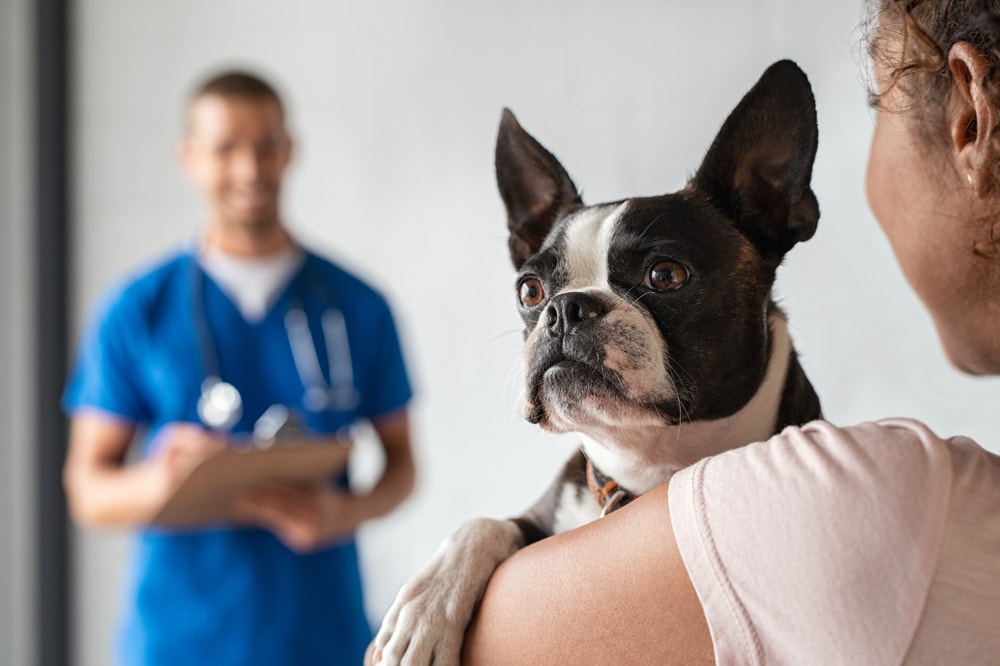
How Do I Know When My Dog Is in Labor?
It would be great if labor was a fast process, but unfortunately, it isn’t. In fact, there are three stages that your Boston Terrier will have to go through before the process is complete.
1. Stage One
The first stage of labor can last for a full day. During this time, your Boston Terrier will experience contractions and feel the intensity of these contractions increase as time moves on. You may notice your dog panting a lot, moving around restlessly, and refusing to eat.
2. Stage Two
Stage two is the exciting part—it’s when the puppies are delivered. This stage varies depending on the number of puppies your dog has. Boston Terriers don’t usually have large litters, as they typically give birth to three to four puppies on average.
It usually takes a dog between 1 to 2 hours to deliver a puppy, so with a litter of four, your Boston Terrier may remain in this stage for around 4 to 8 hours. However, each delivery can be up to 60 minutes apart, so it’s hard to predict how long your dog will remain in this stage.
3. Stage Three
Stage three goes hand-in-hand with stage two and is completed when the last placenta has been delivered.
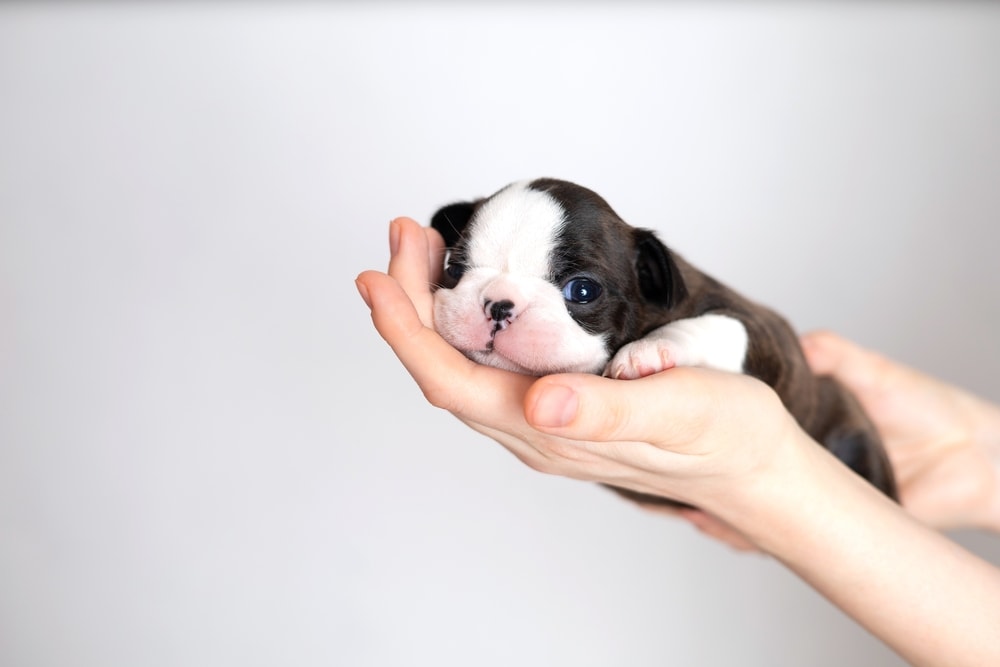
Why is Natural Birth Risky?
Although some Boston Terriers are able to give birth to their litter of puppies naturally, many have birth difficulties and may require a C-section to safely remove the puppies. This is quite common among small breeds of dogs and isn’t unique to Boston Terriers.
Dystocia is the name for difficulties during birth, whether the problems are caused by the mother or the puppies. Dystocia can be caused by obesity, old age, birth defects in the puppies, positioning, the shape or size of the birth canal, and the size of the puppies.
If your female bred with a Boston Terrier that was the same size or larger than her, there is a greater risk for dystocia because the puppies might be too large for the smaller mother’s cervix. If the male was smaller than the female, the risk would be lower.
Signs of Complications
It’s helpful to know how many puppies your dog is carrying to know when labor is over or when there’s a problem. Your vet will be able to inform you on how many puppies to expect through an x-ray or ultrasound.
If your Boston Terrier has been in labor for longer than a day or hasn’t delivered another puppy within 2 hours and you know that all the puppies aren’t out yet, you should contact your vet.
- Green-colored discharge
- Signs of labor before 57 days
- No signs of labor after 70 days
- If stage one of labor lasts longer than a day
- Fever
- Vomiting
- Collapsing and shaking
- If a puppy is stuck
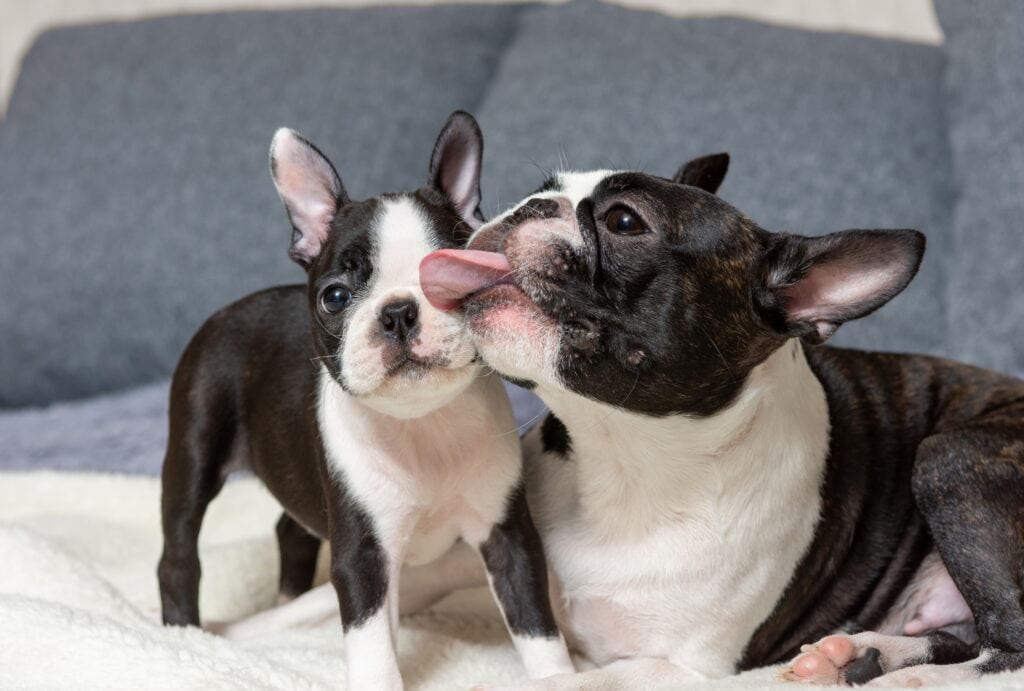
Final Thoughts
If you have chatted with your vet and have decided to breed your Boston Terrier, make sure it’s after the first heat cycle and preferably once they have reached the age of 2. You have two attempts at breeding your dog per year, as their heat cycle only occurs once every 5–6 months. There are various methods your vet can use to determine whether your dog is pregnant, and depending on how far along your Boston Terrier is, be able to determine how many puppies they’re pregnant with.
Set up a safe, quiet, and draft-free area for your Boston Terrier to give birth comfortably. Add in extra warmth if necessary, and stay in communication with your vet in case of an emergency. Look out for signs of dystocia and call your vet straight away if anything looks out of the norm.
Featured Image Credit: Anna Brusnicyna, Shutterstock


 Boston Terrier Pregnancy Symptoms
Boston Terrier Pregnancy Symptoms


